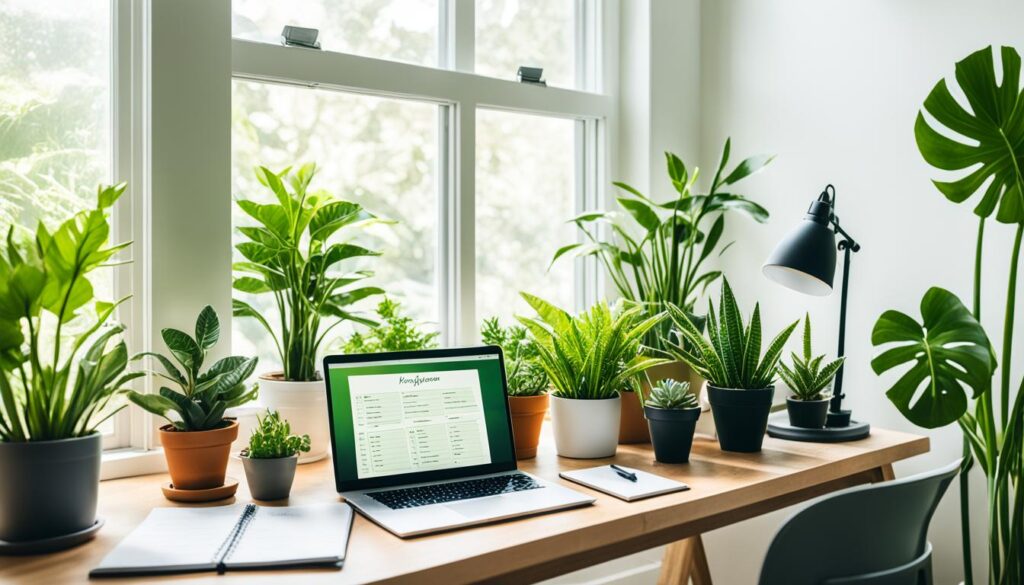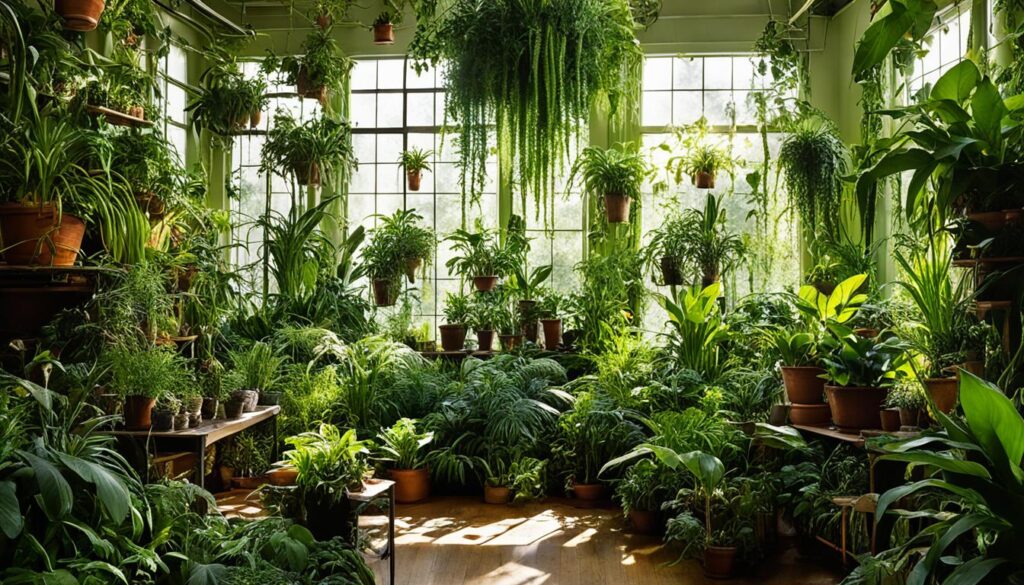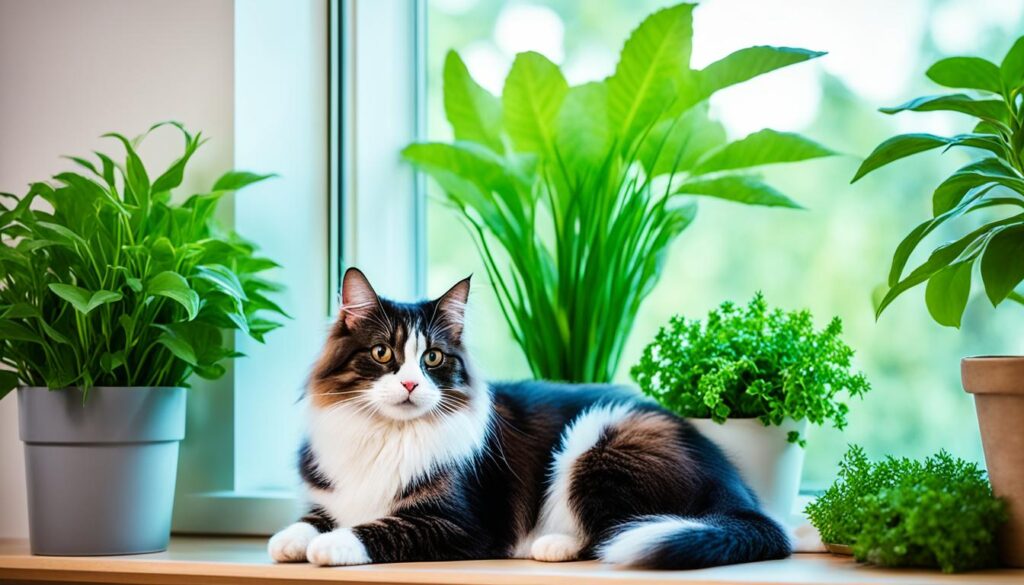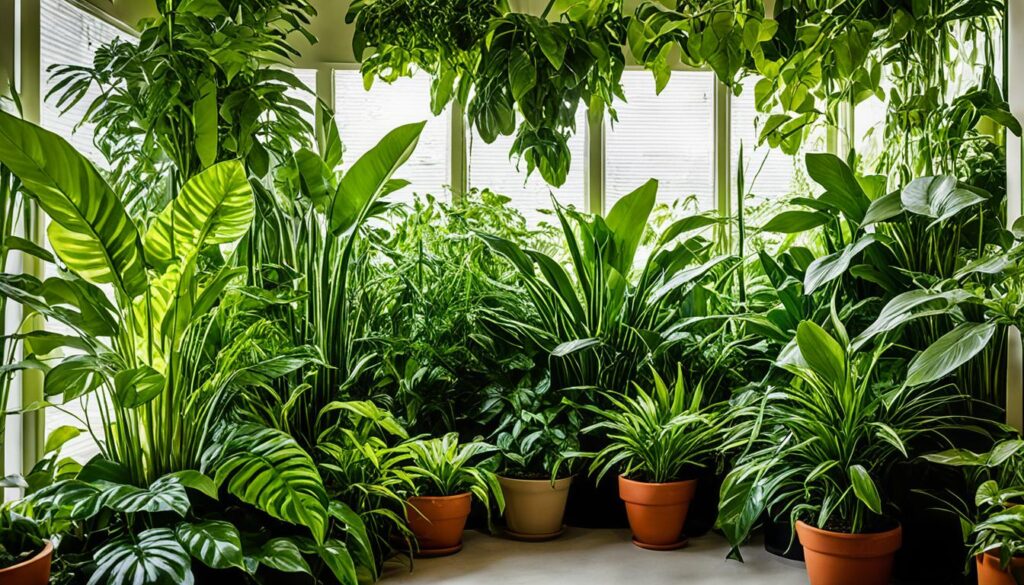Houseplants do way more than just look pretty. They clean the air, boost your mood, and help you focus. The benefits of beneficial houseplants are amazing. They include air-purifying plants, low-maintenance greenery, and plants that give off oxygen.
Houseplants make our living and working spaces better. Whether it’s a bedroom or an office, they bring life everywhere. Plus, they’re easy to care for with just some light and water. Studies show indoor plants make you feel good. They reduce stress, lessen fatigue, and even purify air to help with asthma and dry skin.
Are you excited to learn more about wonders of beneficial houseplants? They can turn your spaces into lively, natural home decor spots. Let’s talk about biophilic design and stress-reducing flora for your home and plant parenthood journey.
IN THIS ARTICLE
ToggleIntroduction to Beneficial Houseplants
Having beneficial houseplants in your home or at work is great. They look nice and bring health advantages. These air-purifying plants can take in harmful substances like formaldehyde from indoor items.
Aesthetic Appeal and Health Benefits
They add beauty to your space and clean the air. A study at Virginia Tech showed that houseplants could lower indoor dust by 20%. This makes them natural air fresheners.
Improving Indoor Air Quality
Plants add moisture to the air, which is good for breathing and skin. They balance out the drying from heaters. This is super for anyone with breathing problems, headaches, or allergies.
| Plant Species | Air-Purifying Capabilities | Maintenance Requirements |
|---|---|---|
| Snake Plant | Removes benzene, formaldehyde, trichloroethylene, and xylene | Low-maintenance, thrives in indirect light |
| Peace Lily | Removes formaldehyde, benzene, and trichloroethylene | Moderate water needs, partial shade preferred |
| English Ivy | Removes formaldehyde, benzene, and airborne fecal matter | Requires moist soil, indirect light |
| Chinese Evergreen | Removes formaldehyde, benzene, and xylene | Tolerates low light, average watering needs |
NASA’s Research on Air-Purifying Plants
NASA has looked into how houseplants can clean the air. They want to use this knowledge on future space stations. Some plants are very effective at getting rid of bad stuff in the air. This is great news for our health and well-being indoors.
Recommended Number of Plants for Optimal Benefits
NASA recommends having 15-18 plants in a 1,800-square-foot home to get the best air-cleaning results. Not everyone can fit that many plants, though. Even a few in the right spots can help. Dr. Virginia Lohr from Washington State University says just 2% of a room with plants makes a difference.
Enhancing Oxygen Levels and Humidity
Houseplants are key in boosting the oxygen and humidity inside buildings. They take in carbon dioxide and give off oxygen as they grow. This improves the air quality significantly. The Seattle Times says placing them within 6 to 8 square feet of where you sit helps the most.
Improved Respiratory Health
Plants raise the moisture in the air, which is great for your breathing and skin. If your home is dry from heating, this is a big benefit. It especially helps people with respiratory health issues, allergies, and headaches.
Oxygenation and Mental Focus
Raising the oxygen inside through indoor plants also boosts our mood and mental focus. Nature’s touch in our rooms and offices can increase how well we think, act, and our general happiness.
Boosting Concentration and Productivity
Many studies prove that being near plants helps concentration and mood. Having indoor plants in your office can boost your work. It’s why new tech offices often look like forests or tropical places. These areas are not just nice to look at. They also make you feel and work better. We naturally connect with nature. So, having nature around us makes us calmer and more focused.
Biophilic Design in Workspaces
Adding biophilic design to workspaces is changing how well employees work. Things like lush indoor gardening bring nature inside. This makes the office more than just a place to work. It makes it a place of calm and happiness, helping employees do their best.

Beneficial Houseplants for Stress Reduction
Outdoor activities like forest bathing and mindful nature walks help lessen stress, anxiety, and depression. Similarly, having beneficial houseplants indoors can improve your mental state. Matthew Wichrowski, a clinical assistant professor, says plants can make us feel better. A biophilic space improves your mood and decreases depressive thoughts.
Nature’s Calming Influence
Having plants near you offers both physical and psychological benefits. Taking care of these plants can reduce stress and anxiety. The calm that nature’s influence brings into your home helps your well-being.
Horticultural Therapy and Mental Well-being
Participating in horticultural therapy like potting or watching plants grow can bring calm and mindfulness. This interaction with nature can reduce depression and anxiety. It helps improve mental well-being significantly. The simple yet meaningful encounters with plants contribute greatly to mental health.
Healing Power of Houseplants
The healing power of houseplants does a lot more than making a space look nice. They can improve the air and make you feel better, too. Studies show having plants around can help people feel less pain and heal faster, maybe even without as much medication.
Faster Recovery from Illnesses
Having houseplants close by might lower your blood pressure and slow your heart rate. Scientists are studying whether plants can make it easier for patients to handle pain. Looking at recent research, in 2002, a report found that patients got better from operations quicker if they could see plants. They needed less pain medication and left the hospital sooner.
Pain Management and Reduced Medication Needs
The calm that houseplants offer can help patients deal with suffering and ease. This is encouraging healthcare workers to think about using houseplants in treatments. By bringing in nature’s healing power with houseplants, they hope to speed up recovery and lower the need for pain drugs.

Low-Maintenance Greenery for Your Space
Is your low-maintenance greenery indoors not looking as good as it could? No worries. We have lots of indoor gardening tips and tricks for you. Check out our Indoor Plant Resource page and our Blog for advice. Also, visit our Monthly Gardening Tips page for seasonal pointers on care and maintenance.
If you’re new to caring for plants indoors, don’t panic. Our guides are here for you. They’re made to help beginners and experts alike. With a bit of care, your home can become a place filled with healthy plants. This not only looks nice but also boosts your mood and cleans the air.
Selecting Pet-Friendly, Non-Toxic Plants
When you put new plants in your home, make sure they’re safe for pets and kids. Check with experts like your state’s plant advice service or the ASPCA. They can warn you about poisonous plants. Some dangerous ones are amaryllis, aloe vera, and English ivy. Also, watch out for jade, lilies, and pothos.
Common Toxic Plants to Avoid
Choose pet-friendly and non-toxic plants for your indoor garden. Make your space beautiful and safe by avoiding dangerous plants. With a little research, you can have healthy plants that won’t harm your family.

Caring for Your Indoor Oasis
Taking care of your indoor gardening realm is a key task. Houseplants bring many benefits but need proper care to avoid pests and other problems.
Watering and Repotting Tips
Understanding how much each plant needs to be watered is vital. Too much water can lead to mold and fungus gnats. Also, when you change a plant’s pot, using garden soil is risky. This soil might bring in pests and diseases.
Pest Control and Allergy Considerations
Regularly check your plants for signs of bugs, like eggs or holes in the leaves. Catching these problems early can stop them from spreading. If you’re worried about allergies, most indoor plants don’t make a lot of pollen. Yet, if you’re sensitive to moisture issues, keep an eye on how wet your plant soil is.
Embracing the Joys of Plant Parenthood
I’m now hooked on houseplants and love every growing plant. Plant collecting has become my thing. These green wonders are like mini miracles in my home. It amazes me to see the different kinds of green that support life. We breathe out carbon dioxide; they give us life with oxygen. Their colors and leaves are a reminder of the marvels of nature.
They teach us waiting when we hope for new shoots. They bring us joy when we spot fresh leaves. A browning plant part tells us it needs help, while its growth shows progress. Amidst a life surrounded by technology and concrete, having plants brings nature closer. It connects us to the true beauty of life.
Getting into indoor gardening and enjoying houseplants has enriched my life. In this digital age, they let me bond with nature at home. Being a plant parent is very fulfilling. I get to watch these plants grow, each with its own character and care needs. It shows me the fragile dance of life and how important looking after things is.

Beneficial Houseplants: Purifying the Air
NASA studied how beneficial houseplants clean the air. They want to use this in future space stations. Certain air-purifying plants are really good at getting rid of harmful toxins indoors. For a 1,800-square-foot house, NASA says you need 15-18 houseplants to clean the air well.
NASA-Recommended Air-Purifying Species
Not all of us have space for that many plants. But, a few of the NASA recommendations for air-purifying plants can still help. NASA has found some plants work really well for this:
- Spider Plant (Chlorophytum comosum)
- English Ivy (Hedera helix)
- Peace Lily (Spathiphyllum)
- Bamboo Palm (Chamaedorea seifrizii)
- Snake Plant (Sansevieria trifasciata)
- Chinese Evergreen (Aglaonema)
Creating a Biophilic Environment at Home
Humans feel deeply connected to nature. Bringing nature close has a big impact on our well-being. Adding biophilic design like indoor gardening and natural home decor can make our home a calm and healing place. This boosts focus, happiness, and lowers stress.
Being in nature or around trees helps with stress, anxiety, and feeling down. Just like outdoor time, having indoor plants can make a big difference. The green around us helps our mind and body feel at peace. Matthew Wichrowski, an expert in horticultural therapy, says that creating spaces with plants can lift our mood and fight sadness.
Using biophilic design in your house allows you to tap into nature’s healing powers. It can be as simple as a garden inside, a living room full of plants, or art inspired by nature. This mix of natural home decor and indoor gardening can take us to a place of peace, focus, and happiness.



